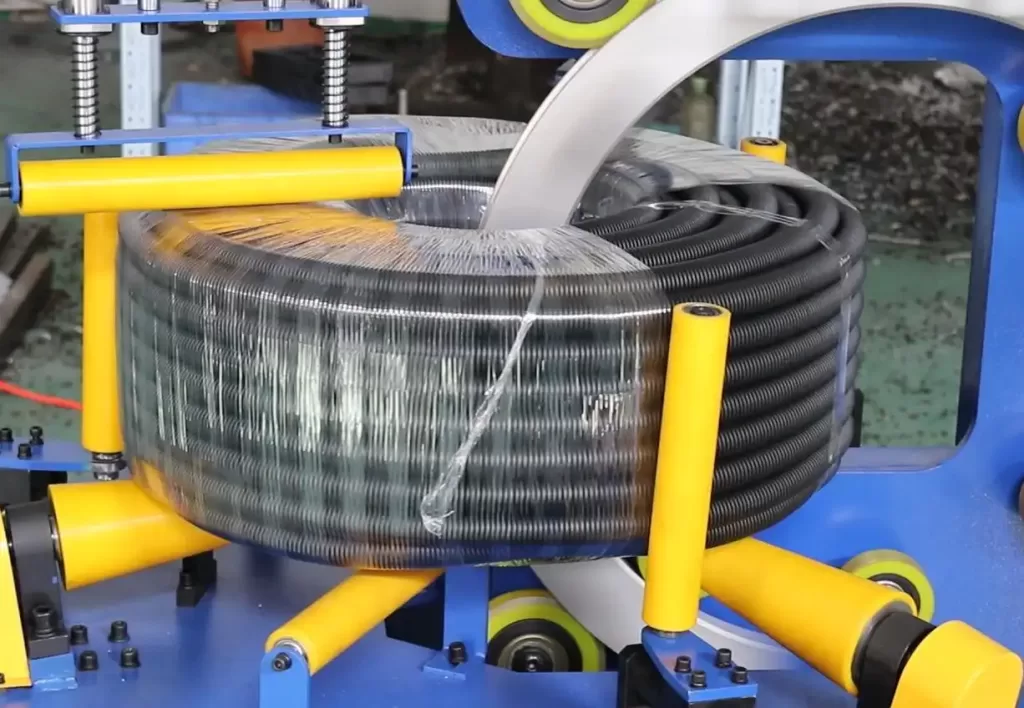Optimizing HDPE Pipe Coil Packaging with Automated Wrapping Systems
High-density polyethylene (HDPE) pipe is valued across numerous industries for its durability, flexibility, and resistance to corrosion. However, handling and packaging large, heavy coils of HDPE pipe presents logistical challenges. Ensuring these coils are packaged securely and efficiently is crucial for preventing damage during transport and storage, maintaining product integrity, and managing operational costs. Investing in an HDPE pipe coil wrapping machine offers a robust solution to automate this process, improving efficiency, consistency, and safety in demanding fabrication and manufacturing environments.
Understanding HDPE Pipe Coil Wrapping Machines
An HDPE pipe coil wrapping machine, often a type of orbital stretch wrapper, is specialized industrial equipment designed to automatically apply stretch film around coiled pipe. The machine typically features a rotating ring or arm that carries the film dispenser and travels around and through the center of the coil. This automated process ensures the pipe coil is tightly secured, unitized, and protected from environmental factors like dust, moisture, and UV radiation.

Key Operational Advantages of Automated Wrapping Systems
Transitioning from manual or semi-automated methods to a fully automated HDPE pipe coil wrapping machine delivers measurable benefits:
Enhanced Throughput and Efficiency
Manual wrapping is labor-intensive and time-consuming. Automated systems significantly increase packaging speed, allowing operations to handle higher volumes of pipe coils consistently. This boosts overall throughput, reduces bottlenecks in the production line, and ensures packaging keeps pace with manufacturing output.
- Reduced Cycle Times: Machines operate at consistent, optimized speeds.
- Minimized Handling: Automation reduces the need for manual manipulation of heavy coils during the wrapping phase.
Consistent Package Quality and Load Security
Automated wrappers apply stretch film with precise tension control and consistent overlap, creating a secure, stable package every time. This uniformity is difficult to achieve manually.
- Improved Protection: A tight, even wrap protects pipes from shifting, abrasion, and contamination during shipping and handling.
- Professional Appearance: Consistent packaging enhances the professional presentation of finished products.
- Optimized Film Usage: Advanced film delivery systems, such as powered pre-stretch units, elongate the film before application (often by 200-300%), maximizing film yield and reducing material consumption per coil compared to manual methods.

pipe coil wrap machine2 Reduced Operational Costs
While requiring an initial investment, automation leads to significant long-term savings:
- Lower Labor Costs: Automating the wrapping process frees up personnel for other value-added tasks, reducing direct labor expenditure on packaging.
- Material Savings: Precise control over film application and pre-stretching minimizes film waste.
- Decreased Product Damage: Secure wrapping reduces the likelihood of damage during transit, lowering costs associated with returns or replacements.
Essential Features and Technologies in Modern Wrapping Machines
Selecting the right HDPE pipe coil wrapping machine involves understanding the available technologies:
Film Delivery Systems
The heart of the machine, this system dictates wrap quality and film efficiency. Key features include:
- Powered Pre-Stretch: Crucial for maximizing film economy and ensuring load stability. Look for adjustable pre-stretch ratios.
- Variable Tension Control: Allows adjustment of film tension based on the coil size, weight, and stability requirements.
Control Systems and Automation
Modern machines utilize PLCs (Programmable Logic Controllers) for reliable operation and integration capabilities.
- User-Friendly HMI: Intuitive touchscreen interfaces simplify setup, operation, and troubleshooting. Operators can easily select wrap programs, adjust parameters, and monitor machine status.
- Sensors: Photo-eyes detect the coil's presence and dimensions, enabling automated wrap cycles. Safety sensors ensure operator protection.
- Integration Potential: Machines can often be integrated into larger automated production lines, communicating with conveyors and other upstream/downstream equipment.
Machine Configuration and Adaptability
HDPE pipe coils vary significantly in diameter, width, and weight. The wrapping machine must accommodate this variability.
- Adjustable Wrapping Ring/Arm: The machine should handle the expected range of coil sizes.
- Conveyor Systems: Integrated infeed and outfeed conveyors facilitate smooth coil transfer through the wrapping zone.
- Robust Construction: Given the weight of HDPE coils, machines must be built for heavy-duty industrial use.
Implementation Considerations
Successfully integrating an automated pipe wrapping system requires careful planning:
Safety Standards and Features
Operator safety is paramount. Ensure the machine complies with relevant safety standards (e.g., ANSI/PMMI B155.1 for packaging machinery). Standard safety features include:
- Perimeter guarding or light curtains to prevent access during operation.
- Emergency stop buttons readily accessible.
- Interlocked access doors.
Integration with Existing Workflow
Consider how the machine fits into your current material flow. Assess space requirements, power needs, and conveyor compatibility. Proper integration minimizes disruption and maximizes efficiency gains.
Material Selection and Sustainability
Evaluate the types of stretch film compatible with the machine. Consider options for:
- Film Gauge (Thickness): Balancing strength and material cost.
- UV Inhibitors: If coils are stored outdoors.
- Recyclable Films: Aligning with corporate sustainability goals. Many standard LLDPE stretch films are recyclable; check local capabilities.
Evaluating the Investment
The justification for investing in an HDPE pipe coil wrapping machine extends beyond the initial purchase price. A thorough analysis should include:
- Total Cost of Ownership: Factor in installation, training, maintenance, spare parts, and energy consumption.
- Return on Investment (ROI) Calculation: Quantify savings from reduced labor, lower film costs, decreased product damage, and increased throughput. Compare this to the investment cost over a realistic timeframe.
- Intangible Benefits: Consider improvements in operator ergonomics, workplace safety, package consistency, and customer satisfaction.

corrugated hose and pipe packing wrapping machine1 Conclusion
For fabricators and manufacturers dealing with HDPE pipe coils, manual or inefficient packaging methods can hinder productivity and increase costs. An HDPE pipe coil wrapping machine offers a reliable, automated solution that enhances operational efficiency, ensures consistent package quality, reduces labor and material expenses, and improves overall safety. By carefully evaluating machine features, integration requirements, and the potential ROI, businesses can make a strategic investment that strengthens their packaging operations and contributes positively to their bottom line in today's competitive industrial landscape.

